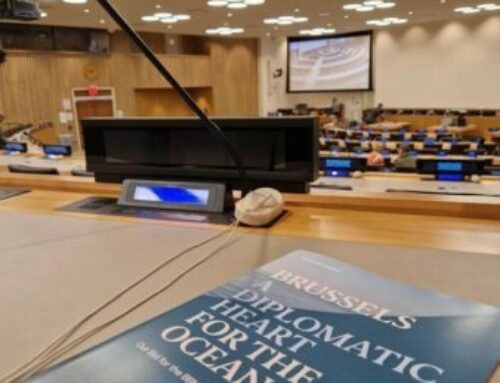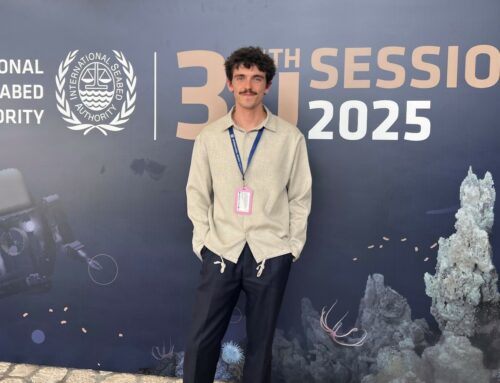The second meeting of the Preparatory Commission (PrepCom II) of the UN Agreement on Biodiversity Beyond National Jurisdiction (BBNJ Agreement) wrapped up after two weeks of intense deliberations in New York from 18-29 Aug 2025. This PrepCom’s task was to discuss 9 topics across 3 clusters to prepare for the Treaty’s smooth entry into force, expected by the end of this year or early next year. The two additional ratifications announced during the session brought fresh momentum to the room. With the Agreement edging closer to entry into force, the question remains: has BBNJ PrepCom II moved us any closer to making it fully operational?
Written on site by Wenwen Lyu
This activity was conducted as part of the Collaborative Event Ethnography (CEE) under the TwinPolitics project, led by Prof. Alice Vadrot and funded by the European Research Council. Wenwen Lyu has covered the BBNJ negotiations intensively throughout the year. You can find her work on BBNJ PrepComI here and here.
In addition to BBNJ, other venues of research include the International Negotiating Committee (INC) on a Plastic Treaty and the International Seabed Authority.
After a short intersessional period (see my report on the first session, held from 14–25 April 2025), delegates reconvened at UN Headquarters in New York from 18–29 August 2025 for PrepCom II under the BBNJ Agreement.
Building on the momentum of the third UN Ocean Conference in Nice, and with Cabo Verde as well as Saint Kitts and Nevis ratifying during PrepCom II, the number of ratifications has now reached 55 (54 states plus the EU). Only six more are needed to cross the threshold of 60. With several countries expected to deposit their ratification instruments during the UN General Assembly’s High-level Week this September, the treaty could realistically enter into force by the end of this year or early next, paving the way for the first Conference of Parties (COP1) by the end of 2026.
As the co-chair noted, ‘we now have a much better sense of the finish line.’ PrepCom II and the upcoming PrepCom III (23 March–2 April 2026) are expected to deliver the groundwork for COP1 and ensure the early operationalization of the Agreement. Over the past two weeks, the co-chairs, the interim Secretariat, and delegations worked tirelessly to advance preparations for COP1. Now, after two intense weeks of negotiations, it is time to take stock: What has PrepCom II delivered? Are we any closer to an operational agreement? What obstacles remain on the path to consensus? And what can be expected in the intersessional period to keep up the momentum toward PrepCom III?

Negotiations unfolded in CR4, where the sessions were also broadcast live via webcast (Photo: Wenwen Lyu)
Overview: what has been delivered by PrepCom II?
PrepCom II was characterized by a heavy workload, with eight parallel sessions, mixed meeting formats, and the release of documents during the two-week proceedings. Three informal working groups were established to advance key strands:
- Governance Issues: covering the Rules of Procedure of the COP (COP RoP), Terms of Reference and Modalities of Subsidiary Bodies (SBs), the arrangement for the functioning of the Secretariat, cooperation with relevant legal instruments and frameworks and relevant global, regional, subregional and sectoral bodies (IFBs), and reporting requirements.
- Clearing-House Mechanism (CHM): focusing on finalizing the Terms of Reference for the informal group on the technical aspects of CHM.
- Financial Issues: including financial rules, arrangements with the Global Environmental Facility (GEF), and operationalizing provisions on other financial resources and mechanisms.
Navigating these diverse topics was challenging. To maximize the use of conference room capacity and achieve the objectives of PrepCom II, delegations agreed on a flexible approach, switching swiftly between topics, particularly during the second week.
Together with my remote support, Hristina Talkova, we took detailed field notes (see Vadrot et al, 2025 for methodology) of all public meetings, including plenary sessions, informal working groups, and informal informals. This allowed us to produce the following timeline and deliverables of 9 topics across the three clusters (GEF9 replenishment was under ‘other issues’ but was put under the cluster of financial issue here), showing when discussions took place, when refreshed or new texts were released, and the outcomes (The topics in orange are under 1st cluster, green under 2nd cluster and blue under 3rd cluster. 🗣️stands for discussion, 📄for document release, 🔜for next step which is based on the author’s observation and the unedited version of the statement by the Co-Chairs ).
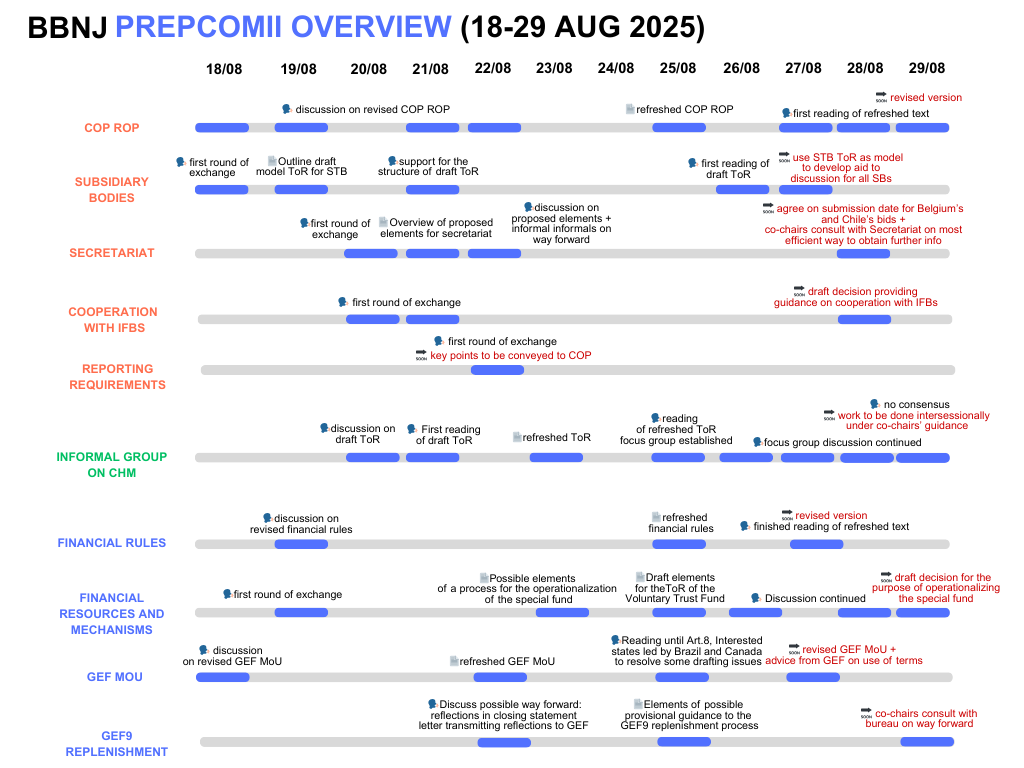
Timeline and deliverables of BBNJ PrepCom II, made by author (click here to download the pdf version)
Overall, PrepCom II made significant progress, moving six topics into text-based negotiations (four aids to discussion and two draft decisions) for PrepCom III (up from three after PrepCom I). Notable advances were achieved on the COP RoP, following a comprehensive reading and the establishment of a small group to address contentious issues. Similarly, discussions on Subsidiary Bodies resulted in a draft model ToR for the Scientific and Technical Body (STB) and completion of its first reading. Financial issues, including financial rules, the GEF Memorandum of Understanding (MoU), the special fund, and the voluntary fund, also received balanced and sufficient attention, enabling all of them to advance into text-based negotiations.
PrepCom II was expected to deliver on two time-bound issues. The first was possible inputs to the GEF-9 replenishment. As the third GEF replenishment meeting is scheduled for 19–21 January 2026, the PrepCom II has a final opportunity to provide guidance. While the co-chairs drafted elements of provisional guidance, delegations were unable to reach consensus. As the Core Latin American Group (CLAM) noted, these inputs involve substantive programming priorities that require careful discussion. Although consensus was not achieved by the end of PrepCom II, the possibility for PrepCom to provide inputs remains open, depending on co-chairs’ consultation with the Bureau during the intersessional period. The second expected outcome was the finalization of the Terms of Reference (ToR) for the informal group on the CHM. Despite intensive discussions, delegations could not agree on the groups’ composition and nomination process. However, as the co-chair emphasized, ‘the work will get done.’ Delegations voiced strong support for the co-chairs, in consultation with the Bureau, to address the tasks during the intersessional period.
With this overview in place, the following sections outlines and analyzes the key considerations within the three issue clusters.
Setting up rigorous governance structures
The art of balance: COP, SBs and Scretariat
One of the most essential topics under the governance cluster is the COP Rules of Procedure (RoP). Delegations resumed negotiations from PrepCom I based on a revised text of COP RoP (A/AC.296/2025/12). Divergences remain on several issues, including meeting formats, operationalization of emergency measures, observer participation, voting, composition of the Bureau, the relationship with IFBs and SBs, and decision-making. In particular, Rule 3bis (in-person and/or virtual participation) and Rule 3ter (meetings on emergency measures) were the subject of lengthy debate, leading to the creation of a small group, coordinated by Norway and Singapore, to work on these rules during the intersessional period.
Across these and other rules discussed, a key issue was how to balance rigor with efficiency in decision-making. As the ultimate decision-making body under the BBNJ Agreement, the COP is mandated to exercise the highest level of rigor in guiding, overseeing, and deciding on BBNJ implementation. Yet, with meetings scheduled only once a year initially and later moving to a biennial cycle, efficiency is equally critical. This tension has shaped discussions on how to operationalize COP’s mandate in practice. Delegates wrestled with questions such as: how to enable emergency measures during intersessional periods; whether and under what conditions to allow virtual meetings; to what extent SBs can operate independently from the COP; and what kinds of voting procedures and quorum rules could both safeguard consensus and prevent deadlock. These questions continually test delegates’ vision of a COP that is both rigorous and efficient. Achieving consensus on the COP RoP will require a careful balance.
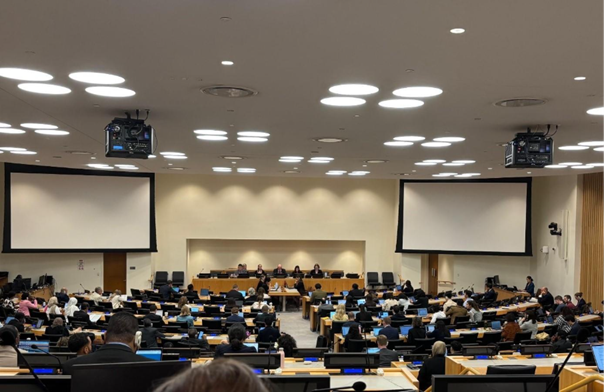
Negotiations in CR2, where the parallel sessions without interpretation took place (Photo: Wenwen Lyu)
Moving to Subsidiary Bodies, discussions focused on the Scientific and Technical Body (STB), the draft Term of Reference (ToR) of which will be used as a model for drafting ToRs for other SBs. The STB is tasked to provide scientific and technical advice to the COP based on best available science. The tension of how to set up this body is on balancing autonomy with the risk of politicization (as highlighted by my previous blogpost and Gaebel et al.,2024). At PrepCom II, debates reflected this tension in several ways. Beyond the disagreement over whether the chairs of subsidiary bodies should have voting rights, delegates expressed differing views on several issues: whether the chair of the STB should be elected by its members or appointed by the COP; the extent to which the COP should influence the STB’s work programme; whether a formal voting procedure is necessary within the STB; and how external expertise should be integrated in practice. While granting the STB sufficient autonomy is essential to safeguard its scientific integrity and efficiency, there are also concerns that an unchecked STB could open the door to political interference.
The discussion on possible models for the Secretariat gained depth with the aid of a matrix prepared by the Secretariat (A/AC.296/2025/INF/4), which outlined four existing models: the International Seabed Authority (ISA), United Nations Framework Convention on Climate Change (UNFCCC), Convention on Biological Diversity (CBD), and Minamata Convention. The discussion reflects a balance between the benefits of maintaining a linkage to the UN and the need for the BBNJ Secretariat to have a degree of autonomy. An interesting question raised by the Alliance of Small Island States (AOSIS) concerned the selection of the head of the Secretariat. Two options were put forward: following the UNFCCC model, where the UN Secretary-General appoints the head in consultation with the Bureau; or alternatively, having the head selected directly by the Parties. This raises a practical issue: if the head is accountable only to the Parties, can the head still benefit from all the privileges and immunities of the UN? To enable delegations to make an informed choice between models, it is therefore important to obtain concrete information on these implications.
Cross-cutting issues: cooperation with IFBs and reporting requirements
Although under the cluster of governance issues, the cooperation with IFBs and the reporting requirements are practically considered as cross-cutting. Cooperation with IFBs was a key issue at this PrepCom, highlighted by the participation of delegates from the Convention on Biological Diversity (CBD), the Food and Agricultural Organization of the UN (FAO), the International Seabed Authority (ISA), regional seas conventions, Regional Fisheries Management Organisations (RFMOs), and other intergovernmental organizations, as well as side events hosted by these bodies. In the formal negotiations. There was general convergence that cooperation should occur at multiple levels, including the COP, SBs, CHM, the Secretariat, and Parties. Delegates also discussed that such cooperation should be guided by function: whether formal (e.g., MoUs) or informal (e.g., joint working groups or joint workplans), the arrangement should meet the practical needs at each respective level.
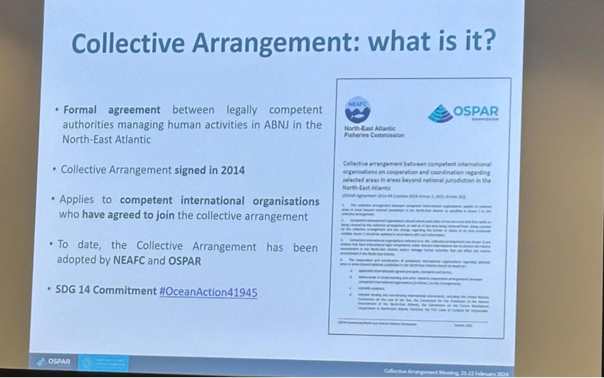
The OSPAR NEAFC Collective Arrangement, slide from side event ‘North-East Atlantic experiences: BBNJ opportunities and challenges’ on 20 Aug 2025 (Photo: Wenwen Lyu)
During the side events, discussions delved into concrete cases and explored potential areas for collaboration. For example, the cooperation between the Convention for the Protection of the Marine Environment of the North-East Atlantic (OSPAR) and the North-East Atlantic Fisheries Commission (NEAFC) in establishing Marine Protected Area (MPA) in areas beyond national jurisdiction (ABNJ) was presented as a model for organizations with overlapping geographical coverage and differing sectoral competences. Panellists emphasized the value of ‘real engagement under the collective arrangement’, highlighting OSPAR’s mandate to set standards for MPA designation and NEAFC’s enforcement capabilities in regulating human activities such as fishing.
Data emerged as both a starting point to motivate cooperation and a crucial aspect of collaborative work. As a panellist from the Committee on Fisheries (COFI) noted, ‘while data and information sharing arrangements can be complex, establishing early and focused work on this will help maximize the effectiveness of the engine.’ In the case of ISA–BBNJ cooperation, the ISA DeepData database and the data collected through Regional environmental management plans (REMP) were presented as potential tools for a science-based, data-driven approach to Environmental Impact Assessment (EIA) processes under BBNJ.
Similarly, a side event organized by the United Nations Office on Drugs and Crime (UNODC), the International Union for Conservation of Nature (IUCN), the Allen Institute for Artificial Intelligence, and the High Seas Alliance highlighted the information and data flow on human activities in the High Seas, as well as the enforcement measures for High Seas MPAs. These discussions illustrated the complexity of designating, managing, and monitoring MPAs in the High Seas, where information flows involve multiple stakeholders and intricate legal considerations (Papastavridis & Tzanakopoulos, 2025).
Reporting requirements appear in various provisions of the agreement and involve multiple actors, including Parties, SBs, and the Secretariat. Efficient reporting will also depend on cooperation with existing IFBs to maximize the use of existing data and reporting templates, as well as to support data collection efforts. Key issues frequently raised include how to safeguard data and information confidentiality, ensure compatibility with other reporting processes, and develop joint reporting arrangements. Owing to other priority items on the agenda, reporting requirements were discussed for only one afternoon at this PrepCom. As a pivotal piece of the broader puzzle, it is expected to be the subject of more concrete, text-based discussions at PrepCom III.
CHM: how to translate inclusivity into practice
As one of the key outcomes expected from this PrepCom, the ToR of the informal group on the technical aspects of the CHM (A/AC.296/2025/15) received substantial attention. In the second week, after completing a first reading, delegations identified major points of contention concerning the composition and nomination process. This led to the formation of a focused group, co-led by the UK and the Barbados, to work toward resolving these issues. However, the group was unable to reach consensus on two outstanding matters: the allocation of explicit seats for small island developing States, and the introduction of an objection procedure for nominated experts.
The protracted debate underscored the difficulty of translating inclusivity into practice. Questions arose, for example, on whether and how the nomination process for experts from relevant IFBs and Indigenous People and Local Communities (IPLCs) can work together with existing regional group nomination procedure; how to operationalize the principle of “full recognition of the special circumstances of small island developing States and of least developed countries” (Article 7) in the composition of the group; and how to balance the need for greater participation from developing countries with the financial resources available, given that a larger number of experts would require additional funding.
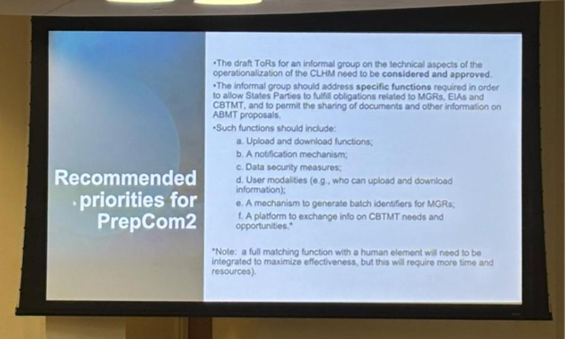
The recommended priorities for PrepCom II on CHM, slide from the side event ‘Unlocking the Clearing-House Mechanism of the BBNJ Agreement’ on 19 Aug 2025 (Photo: Wenwen Lyu)
As one of the most important and arguably the most crucial topics at PrepCom II, the lack of agreement generated a sense of disappointment amongst delegates. However, in their closing remarks, they expressed full trust in the Co-Chairs and the Bureau to advance this issue intersessionally. In this regard, a study by the Natural Resources Defense Council (NRDC), Ocean Care, and the High Seas Alliance identified functions that could be prioritized in the initial phase of the CHM. These functions, including an ‘uploading and downloading, notification and use management system’, are neither resource-intensive nor time-consuming. Such elements could serve as a useful reference for intersessional work.
Financial Issues: balancing on three wheels
The cluster of financial issues included three topics: the overall financial rules (A/AC.296/2025/13), the arrangement with GEF (A/AC.296/2025/14), and the operationalization of other provisions on financial resources and mechanisms (A/AC.296/2025/18). The BBNJ Agreement established three financial mechanisms: the Voluntary Trust Fund to support participation by developing States, the GEF Trust Fund, and a Special Fund.
At PrepCom II, developing countries voiced strong support for advancing all three instruments in a balanced manner. Discussions focused on the timeline for setting up the Voluntary Trust Fund and the Special Fund; which elements should be reflected in the financial rules; whether an oversight body should be created; the role of a finance committee and how it should be reflected in the financial rule; who should administer the Special Fund; how to ensure complementarity between the Special Fund and the GEF Trust Fund; and whether and how to address arrears.
With more details on the Special Fund and Voluntary Trust Fund expected at PrepCom III, discussions are anticipated to deepen, alongside finalizing the GEF MoU and the overall financial rules.
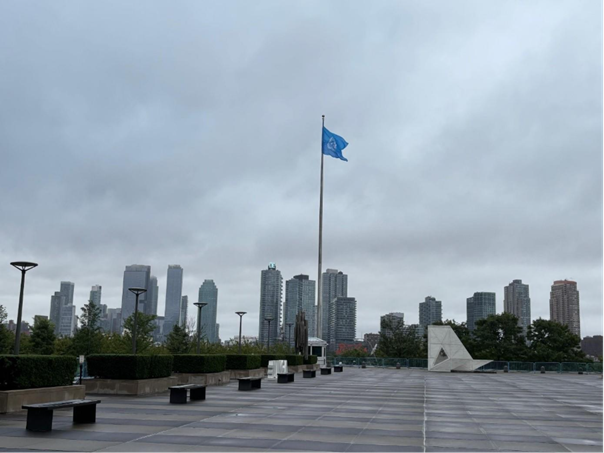
The BBNJ PrepCom II concluded at UN Headquarters in New York (Photo: Wenwen Lyu)
Reflections: what can we expect from intersessional work?
So, are we any closer to an operational BBNJ? As an observer, I left PrepCom II with mixed feelings. On the one hand, the difficulty of reaching consensus was evident, from debates over specific terminology to disagreements on the composition of expert group. The lack of consensus on the ToR for the informal expert group on the CHM, although not regarded as a negative outcome, underscored how technical discussions are shaped by political considerations and reminded us that the negotiation space is inherently political. On the other hand, as I reviewed the deliverables of PrepCom II, I was struck by the constructive and promising tone that emerged. In a relatively short time, delegates succeeded in advancing several crucial issues into text-based negotiations, marking an important step toward an operational BBNJ Agreement.
Unlike the short intersessional period between PrepCom I and II, there is now a longer window until PrepCom III in March 2026, during which much is expected and can be achieved. Based on my own observation and co-chairs’ closing statement, the priorities may include:
- Ensuring the delivery of tasks required for the operationalization of the initial phase of the CHM;
- Preparing updated text on the COP RoP and consulting with delegations on issues such as virtual participation and emergency measures;
- Preparing draft Aid to Discussion documents on the ToRs of the SBs and financial rules, as well as draft decisions on cooperation with IFBs and the Special Fund;
- Way forward in terms of providing possible inputs to GEF9 replenishment process;
- Receiving and reviewing bids from Belgium and Chile to host the Secretariat;
- Considering the GEF’s advice to be provided intersessionally and reflecting it in the refreshed GEF MoU;
- identifying the most appropriate ways to address any overlaps between the financial rules and any potential terms of reference for the voluntary trust fund.
The workload ahead remains substantial, and the efforts invested during the intersessional period will be decisive. They will determine how well PrepCom III can deliver recommendations to COP1 and ensure that COP1 has the strongest possible momentum to operationalize the treaty at the earliest stage.


